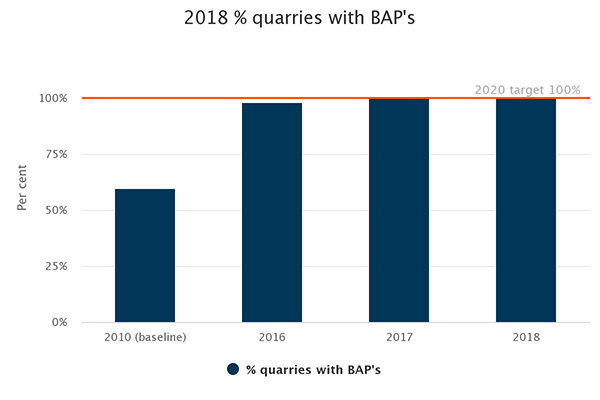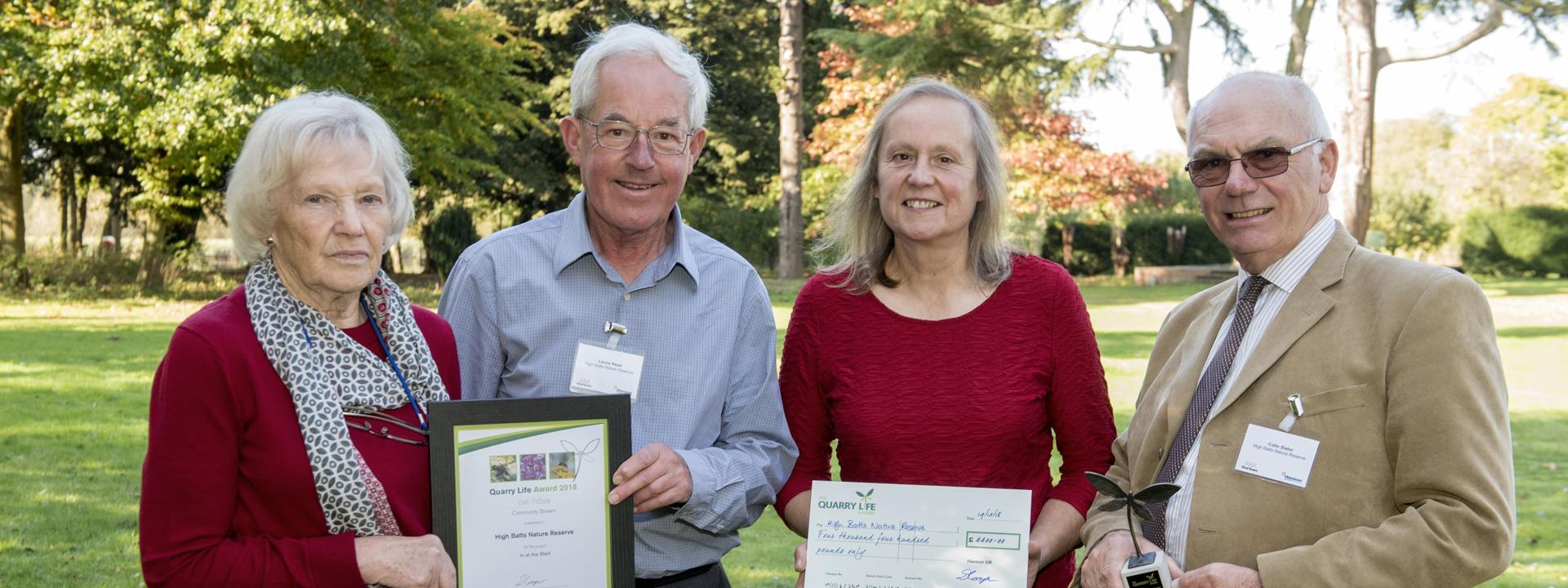Biodiversity and site stewardship
We have biodiversity action plans (BAPs) in place for all our quarries and they are all published on our website along with a number of geodiversity action plans (GAPs). We also have an indicator looking at quarries with high biodiversity value. These are defined as those located within 500 metres of a Site of Special Scientific Interest and all of them have BAPs in place. We have a database to manage actions within our BAPs and track progress.
Eight of our quarries participated in the fourth edition of HeidelbergCement’s biennial biodiversity research competition, the Quarry Life Award (QLA). The 2018 competition was run in 25 countries across the globe and offered academics and students from universities and further education institutions the chance to win up to £27,000 by finding new ideas for the conservation and promotion of biodiversity in quarries.
For the first time the QLA included a category for community projects that educate local people about biodiversity in quarries or help the quarry to better connect with its neighbours.
The UK research section was won by a team from the University of South Wales for a project which looked at the value of moving ancient woodland soils within quarried landscapes at Forest Wood quarry in Mid-Glamorgan. The judging panel, led by consultant ecologist Paul Bradley, managing director of PBA Applied Ecology, praised the project for its strong scientific approach and said it would provide the data to inform some important future decisions about soil translocation.
The award for the best research project submitted by a community group went to High Batts Nature Reserve in Ripon, North Yorkshire, for its “In at the start” project to build a long-term partnership between the local community and the newly open Pennycroft quarry extension.
A UK community project was among the international winners. The “Connecting quarries and communities” award went to the Tice’s Meadow group for the creation of a self-guided biodiversity trail with interpretation panels, notice boards and benches at the former Farnham sand and gravel quarry in Surrey. The volunteer team also created new habitats for natural wildlife, including a woodland bird feeding station and a swift tower.
The 55 hectare Tice’s Meadow nature reserve was officially opened in May 2018. Hanson UK’s principal landscape manager Andy Duncan, who has overseen the restoration and aftercare phase, said: “This site is a terrific example of what can be achieved by being responsive to circumstances, rather than blindly following the plans. The original concept was to restore back to agriculture but as things progressed both Hanson and the county council planners began to see the benefits of a nature-conservation-focused restoration plan.
“It demonstrates the enormous benefits that can be derived from working together and the value that responsible mineral extraction can bring, both to the built environment through our products, and to biodiversity and nature conservation through what we can create and leave behind.”
For more details on the Quarry Life Award visit www.quarrylifeaward.com
Work has been completed to protect a rare plant at Cefn Mawr quarry near Mold in north Wales. Spring sandwort (Minuartia verna) is a delicate plant with white flowers which appear in May and is classed as nationally scarce. The population of these plants at Cefn Mawr is small and confined to a former lead mine spoil heap on the outer perimeter of the site, close to the Loggerheads Country Park.
The plants are vulnerable to natural succession and to inadvertent damage from woodland operations and trampling. Working in partnership with Flintshire County Council and Natural Resources Wales, the quarry team helped to erect temporary fencing to direct visitors away from a path on which the plant grows. Branches and scrub were also removed to allow access to an alternative path, with information signs erected.
An area of limestone grassland at Cefn Mawr has been identified as a particularly rare type found only on a handful of sites in Wales. Natural Resources Wales reclassified the grassland in its annual review of the quarry’s Site of Special Scientific Interest area.

-
Biodiversity and site stewardship
2016
2017 2018 Quarries
57
57 55 Quarries with restoration plans
57
57 55 Quarries with BAPs and/or GAPs
56
57 55 Quarries with BAPs
56
57 55 Quarries with high biodiversity value
35
34 31 Quarries with high biodiversity value and BAPs
35
34 31 Marine BAPs
3
3 3 Total BAPs and GAPs
80
81 79 Note: Quarries are those that that have been operational in the last three years.

